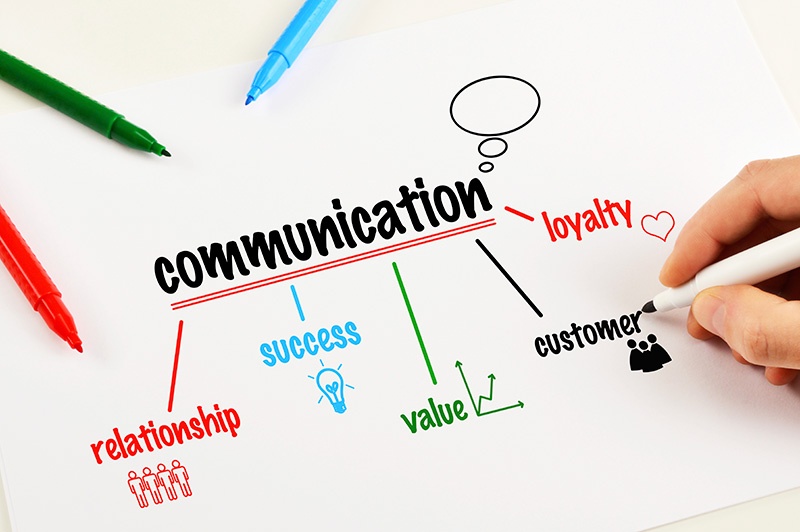How to Craft a Communications Strategy that Maximizes the Customer Experience

Within their walls, most organizations house the talent, offerings, and resources capable of delivering a high value customer experience. They have access to intelligence about what each customer needs, wants or loves most, and the capacity to deliver. They have core values, an origin story, shared dedication to a goal, and pride in the impact they’ve made on the world.
But many neglect to transform their differentiators into a brand narrative. Rather than doing the work to situate their company in the context of customers, competition, and the marketplace, they keep nose to grindstone. They play a simpler, ‘whack-a-mole’ game of responding to competitors and other market factors. The data collects, people do their work, things get made, sales happen, but the stories that could truly engage audiences and build profitable, lasting, loyal relationships sit.
Two words sum up this lack of proactive, strategic communications. Slow death. That may seem overstated. It isn’t. Here’s why.
Competition and Expectations
Don’t think for a moment that your competition isn’t just as able as you are to use communications to connect audiences with their brand. They are. Digital media and content production keep doubling every two years.[1] Organizations have a plethora of stories to tell and lessons to teach, and almost as many digital content delivery channels.
Customers are hungry for information. They’re hyperconnected and capable. Consequently, they expect to engage with the information they want when their whims and needs dictate. Organizations that create a brand presence through digital communication platforms that serve these hungry audiences create a cadence of tailored engagement, enlightenment and entertainment.
The Age of the Consumer
It is known that products and services can be customized and delivered however they desire. This is done as companies continue to gather more and more data about consumers. As information and data is being captured and consumers are demanding customized solutions, we find a shift in power from companies to “prosumers.” This mentality is changing the way that companies need to position their brand.
Prosumers are a powerful mouthpiece for a company’s brand. They are as adept and inclined to use digital media channels to share information as they are to pursue it. The result is companies that do not actively control their brand risk having their customers do it for them, either as advocates or adversaries.[2]
Industry, Not Ideation
The 2nd Wave was characterized by order, standardization, and tangible value. It was a time of industrial production. Organizations were hierarchical and mandate-driven. Those ‘legacy’ structures are segmented into those who deliver to customers, and those who work behind the scenes (e.g., IT, HR, R&D, PMO, etc.) Particularly in today’s climate, that structure robs a company of its full value. It relegates incredibly important producers and traditional lines of business to a backstage role in building brand value. It also constrains true cross-departmental knowledge sharing, collaboration and innovation.
A Future Proof® Solution
Here’s where strategic communications become a pivot point. A huge amount of value comes from those production-oriented background departments. Organizations that will thrive in a Future Proof® environment will have integrated the value of Industrial Age business functions into their customer-focused strategies.
Of all the things you can do to transform your organization toward resilience, this is one of the most organic. You’re not changing the actual work people do, you’re just building a strategy that communicates its value to the audiences that matter most.
Marketing, branding, and communications bring your “backstage” functions to the main stage. It integrates and values those departments and enriches the organization. And it creates more touchpoints with the customer. Building a communication strategy requires that each business function have a vision of their contribution to the customer experience and the brand. And it requires that they have a resonant, relevant set of messages they can share consistently with colleagues and the marketplace.
The Core Elements of a Strategic Communication Plan
- Evaluate and map current and future brand objectives and opportunities, and the market factors that will impact your ability to achieve them.
- Assess how to drive communications and brand uptake by using data to understand, connect with, and serve the customer at each point in the value chain.
- Ask how the organization meets the current and future desires of the customer – and, more importantly, how you communicate that as unique (and better) than your competition.
- Support an internal culture where each department and individual is empowered to contribute toward shared goals.
The ability to recognize the potential of every member to contribute to the brand story is a fundamental attribute of a Future Proof® organization. Empowering employees and divisions to communicate their value gives them the opportunity to brand themselves and the work they do in the context of your shared mission. It widens the exponential reach of their efforts. And for the organization, it enriches and deepens your core value propositions and drives measurable value even as the marketplace changes.
It’s time to transform organizations with a strategy of brand communications and people-driven storytelling.
{{cta(‘befa9ff3-80a5-4a6c-b483-9daadb37b099’)}}
[1] http://www.emc.com/leadership/digital-universe/2014iview/executive-summary.htm
[2] http://www.forbes.com/sites/work-in-progress/2010/07/03/the-shift-from-consumers-to-prosumers/#1652bae8543f
- Categories
- Strategic Planning


 About the Authors
About the Authors